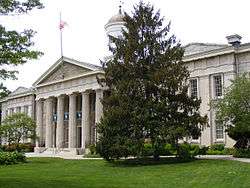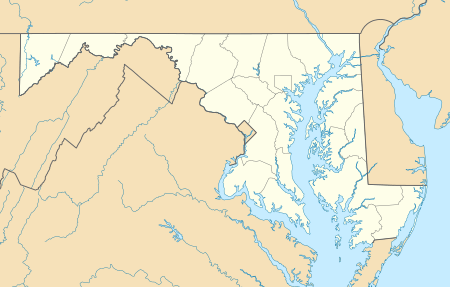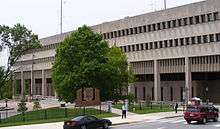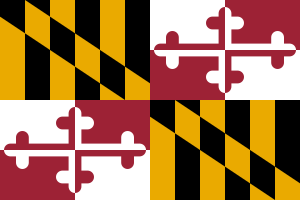Baltimore County Circuit Courthouses
The Baltimore County Courthouses are located in Towson, the county seat. The older, original Baltimore County Courthouse ("Historic Courthouse") of 1854-1856 (and three additions that eventually formed an 'H' shape) houses many of the offices of the County government, including both the executive branch (county executive and their departments/agencies/boards/commissions, etc.) and the legislative branch (County Council). The County Courts Building (known as the "new" courthouse) lies to the west, separated by a plaza. Built in 1970-1971, it houses the civil, criminal, family and juvenile divisions of the Circuit Court of Maryland for Baltimore County, as well as the Baltimore County Sheriff's Office. The latter office protects the Courthouse and its judicial personnel, as well as having countywide law enforcement functions.
Baltimore County Courthouse | |
 Courthouse from northeast | |
  | |
| Location | Washington Avenue between Pennsylvania and Chesapeake Avenues, in Towson, Maryland |
|---|---|
| Coordinates | 39°23′59″N 76°36′24″W |
| Area | 4 acres (1.6 ha) |
| Built | 1855 (additions: 1910, 1925, 1958) |
| Architect | Dixon, Bilbirnie & Dixon; E.F. Baldwin, Josias Pennington, Baldwin & Pennington |
| Architectural style | Greek Revival |
| NRHP reference No. | 72000569 |
| Added to NRHP | October 27, 1972[1] |
Historic courthouses
The historic Baltimore County Courthouse is an edifice of limestone and marble, two stories in height and nine bays in length, surrounded by a modest park and square on the east (and north/south) sides; this is landscaped with a variety of flowers and shrubs and small trees, with winding paths and benches. Several small memorials and historical objects are displayed. The east original facade of 1855-1856 is of Greek Revival-styled architecture, with a portico/porte-cochère that has a pediment supported by fluted Doric columns. The structure is one hundred and twelve feet in length in front, by fifty-six feet in depth. A shallow A-frame roof of the main block is crowned with a centered, eight-windowed, pilastered, frame cupola bearing a domed copper roof.[2]
Originally constructed in 1854–55, at a cost then of thirty thousand dollars ($30,000), the building is one of the few H-plan buildings, public or private, remaining in the State. All of the original exterior treatments are preserved intact.[2]
The Towsontown Courthouse was begun in 1854. It replaced the earlier City/County Courthouses that had been shared since 1768 by both Baltimore Town (and later City) and the surrounding County. The first one was located in old "Courthouse Square", now in downtown. Construction began in the port town of Baltimore in 1768, a year after it was newly designated as the county seat. This had formerly been at old Joppa, a village near the mouth of the Gunpowder River at Chesapeake Bay along the mid-eastern boundaries of the County. Without the court functions, the village declined. Baltimore is located on the Northwest Branch of the Patapsco River and had been founded in 1730.
This second City/County Courthouse was constructed in 1768 across the street from the old public square in downtown Baltimore. It is to the west at the northwestern corner facing East Lexington Street and North Calvert Street. For several years, it faced the empty square of the recently razed earlier colonial-era courthouse. This center city site was considered for the proposed first monument to honor George Washington, commanding General of the Continental Army in the American Revolutionary War and first President of the United States.
The town lay a cornerstone for the new planned Washington column on "Independence Day", July 4, 1814, 15 years after the president's death and during the War of 1812. This was a few months before the massive military attack by British sea and land forces later that September, when they burned the Capitol in Washington, DC. Local home owners feared that the unusually tall column proposed might threaten their houses, and the proposed Washington memorial was moved north of the town to "Howard's Woods" on land donated by Col. John Eager Howard, to the west of his mansion on his estate of "Belvidere". It is now at the center of Baltimore's Washington Square.
The old Courthouse Square had always been a gathering place for news, gossip and protests, along with mass meetings and assemblies of the citizenry. It became the site of a memorial for the soldiers and officers in the Battle of North Point with the British Army, which took place southeast of the city on the Patapsco Neck, as well as honoring those in the bombardment at Fort McHenry during the recent Battle of Baltimore. It was renamed as Battle Monument Square. The second courthouse was built during 1815 to 1822, and its east side faced this square. the east side of the second courthouse faced the new adjoining
Across from the City/County Courthouse was the Battle Monument which replaced the previous first County and Town Courts, later known as the "Courthouse on Stilts" as the 1768 building was temporarily saved from razing when it became necessary to extend Calvert Street further north, so later in 1784, local town builder Leonard Harbaugh erected a new brick/stone foundation under the building resting on arches supporting the building and cut away ground around it enabling the street passage beneath, in the Square at the edge of the cliffs then overlooking the bend of the Jones Falls flowing south to the harbor. This first courthouse in the square, was razed around 1804-1805. It was also here on July 29, 1776, that the recently adopted Declaration of Independence proclaimed three weeks earlier by the Second Continental Congress at the old Pennsylvania State House (now renamed Independence Hall) in Philadelphia, was read to the townfolk along the Patapsco River
The second courthouse of Georgian style was constructed on the southwest corner of then North Calvert and East Lexington streets, opposite the old "Courthouse Square" in which the Battle Monument was erected. The latter was designed by French architect Maximilian Godefroy, (1765-1838), to commemorate "Defenders' Day" (a city, county, and state official holiday) of the British attack on Baltimore. The "rockets red glare, the bombs bursting in air" were lines of a poem, titled "The Defence of Fort McHenry", that soon appeared on printed broadsheets and handbills (from the offices of the Baltimore American) all around town and was soon published in the Baltimore Patriot. It was written by the noted poet and lawyer Francis Scott Key (1779–1843), of Frederick and Georgetown, who had witnessed the bombardment of Fort McHenry from the truce ship Minden anchored downriver on the Patapsco River (probably off Sparrows Point on the north side near the river entrance or the Royal Navy's invasion fleet's landing site at North Point). Key had been invited by officials and neighbors to try to negotiate the release of doctor William Beanes of Prince George's County, who had been captured by the British. Key's poem was set to music in a few days at a local well-known Baltimore theatre and neighboring tavern on Holliday Street. It quickly became known as the "Star-Spangled Banner" and in 1931 was designated by Congress as the National Anthem.
After considerable discussion and agitation for several decades, going back as far as 1835, prompted by a fire of several arsons that year during the economic recession and panic begun with the "Baltimore bank riot" which damaged the downtown second Baltimore County/City Courthouse (then only 20 years old, at the southwest corner of North Calvert and East Lexington Streets). After more recent debates, and votes, with the adoption by statewide referendum of the new second Maryland Constitution of 1851, it contained the provisions for elevating the City of Baltimore to the status of an "independent city" on the same status of all of the other counties of the state and increasing its representation and number of votes/members in each chamber of the state legislature—in the House of Delegates and the State Senate in the General Assembly of Maryland. With the positive vote, the City of Baltimore (which had also functioned as the "county seat" of Baltimore County since 1767, an 84-year tenure) was separated and established as an "independent city" (with the status of one of the twenty-three counties of the State of Maryland) as of July 4, 1851. A subsequent series of votes and referendums by the citizens of the remaining reduced territory of new Baltimore County, voted to move the new county seat to what was then called then "Towsontown", as of February 13, 1854.
Named for the Towson family of early colonial settlers, brothers William and Thomas Towson, who had moved to the area from Pennsylvania in the early 1750s. Their homestead was located near the current "traffic circle" at Joppa, York and Dulaney Valley Roads, and had begun farming at Sater's Hill, just to the northeast. Later, Thomas' son Ezekiel built a log tavern where the modern-day Towson Tavern and the old Towson Theatre building for movies (and currently Recher Theatre for rock music concerts). Ezekiel's tavern soon became a regular stopping place for travelers and farmers heading north out of the city or south with their crops towards Baltimore, beginning the small cross-roads community's place as a commercial place for doing business. Several hundred yards to the northwest at the current 617 York Road, is the wood-frame house of Solomon Schmuck (now a bridal boutique store), which is said by local historians to be Towson's oldest house. He married Catharine Towson, (1767–1834), one of hotelier Ezekiel's 12 children, (and granddaughter to Thomas), so uniting the Schmuck and Towson families. Ezekiel became an important leader in the County and in the local response to the American Revolution. Her carved tombstone, the last upright stone remaining in a small family plot, surrounded by several other unmarked relatives' graves, including the connected Shealey family, was recently surrounded in 2014 by the construction of the "Towson Square" shopping and entertainment development of four acres, costing $85 million, facing East Joppa Road. In addition, a later member of the family attained a nationally known military career who was General Nathan Towson, (1784–1854), veteran of the War of 1812, whose reputation made the small town famous in the early 19th century.
The cornerstone of the new County Courthouse was laid with elaborate ceremonies and a procession, on October 19, 1854, in front of a "numerous assemblage" in what was still then known as "Towsontown". Coleman Yellott, (1821–1870), a local respected attorney delivered the official address and "oratory" for the occasion saying:
The ceremony which you had assembled to witness, has now been performed. The Corner Stone of the building has been laid; and soon the edifice itself will rise towards the Heavens, attracting, by the beauty of its proportions and the simple grandeur of its walls, the admiring gaze of every traveler along yonder highway. May it stand for ages, in sunshine and in storm, firm and unshaken as the hill in which its foundations are planted; and may it ever be pointed to as a temple of Justice!"[3]
Designed by noted local city architects of Dixon, Bilbirnie & Dixon and the famous firm of Baldwin & Pennington (composed of Ephraim Francis Baldwin (1896–1916) and Josias Pennington (1854–1929)). The building was completed in 1855 by the builder, William H. Allen, but the first session of the Court was held here on Monday, January 5, 1857 after a long battle about the land title for the site from Dr. Grafton M. Bosley who owned a large portion of the western side of the town, who had presented it to the county with a "right-of-way" to it from the Baltimore and York Turnpike, and was finally resolved from the nearby turnpike company in December 1856. On the succeeding May 15, 1857, the new courthouse and the jail (two blocks south) were declared finished and formally handed over to the county commissioners. Six years later, the building was the object of an arson attack. According to an article in The New York Times, on Saturday, August 14, 1861, the building was "fired by incendiary". The account goes on to say that the fire was contained to the records office and the rest of the building escaped damage.[4] The building was enlarged in 1910, again in 1925, and a third time in 1958.[2] The building was listed on the National Register of Historic Places in 1972.[1]
County Courts Building

The Baltimore County Courts Building is located on Bosley Avenue in Towson, Maryland. It faces the same public square as does the first, historic Baltimore County Courthouse. (The latter faces east). Sometimes referred to as the "New Courthouse" in the context of these two buildings, it was designed in the modernist style and constructed about 1970. It has white stone panels that match the older building.
It houses the 17 judges of the Circuit Court of Maryland for Baltimore County, the Offices of the Baltimore County State's Attorney, juvenile and equity masters, four retired judges, and nearly 100 support personnel. Courtrooms, judges bailiffs, and staff for the District Courts of Maryland, dealing with lower-level legal matters, are located in several "district courthouses" in various sections of the County, to the east and the west.[5]
References
- "National Register Information System". National Register of Historic Places. National Park Service. March 13, 2009.
- Mrs. Preston Parish (January 1972). "National Register of Historic Places Registration: Baltimore County Courthouse" (PDF). Maryland Historical Trust. Retrieved 2016-03-01.
- Turnbull, J. Grayson (1854-10-19). "Address Upon the Occasion of the Laying of the Corner-Stone of the Court House of Baltimore County". Towson, Maryland: J. Grayson Turbull, II archivist. Cite journal requires
|journal=(help) - "Burning of tho Baltimore County CourtHouse". The New York Times. 1861-08-25. Retrieved 2008-05-14.
- "Welcome to the Judiciary". Baltimore County. Archived from the original on 14 May 2008. Retrieved 2008-05-14.
External links
| Wikimedia Commons has media related to Baltimore County Circuit Courthouses. |
- Baltimore County Courthouse, Baltimore County, including photo from 1989, at Maryland Historical Trust
- Historic American Buildings Survey (HABS) No. MD-338, "Baltimore County Courthouse, Washington Avenue, Towson, Baltimore County, MD", 1 photo, supplemental material



